Tea Market Size 2025-2029
The tea market size is valued to increase USD 19.9 billion, at a CAGR of 5.5% from 2024 to 2029. Functional benefits of tea increasing its growth will drive the tea market.
Major Market Trends & Insights
- APAC dominated the market and accounted for a 62% growth during the forecast period.
- By Distribution Channel - Offline segment was valued at USD 44.80 billion in 2023
- By Product - Black tea segment accounted for the largest market revenue share in 2023
Market Size & Forecast
- Market Opportunities: USD 49.47 billion
- Market Future Opportunities: USD 19.90 billion
- CAGR : 5.5%
- APAC: Largest market in 2023
Market Summary
- The market encompasses a vast and dynamic industry, marked by continuous evolution and innovation. Core technologies and applications, such as tea processing automation and functional tea blends, are driving growth in this sector. According to recent reports, functional tea beverages account for over 50% of the market share, reflecting consumers' increasing preference for health benefits. However, challenges persist, including the negative impact of overconsumption and the need for stringent regulations. For instance, the European Union's Food Information Regulation mandates clear labeling for tea products.
- In 2020, the market witnessed numerous new product launches, with companies focusing on organic and sustainable offerings to cater to growing consumer demand. Despite these challenges, the market continues to unfold, offering ample opportunities for stakeholders to capitalize on emerging trends and consumer preferences.
What will be the Size of the Tea Market during the forecast period?
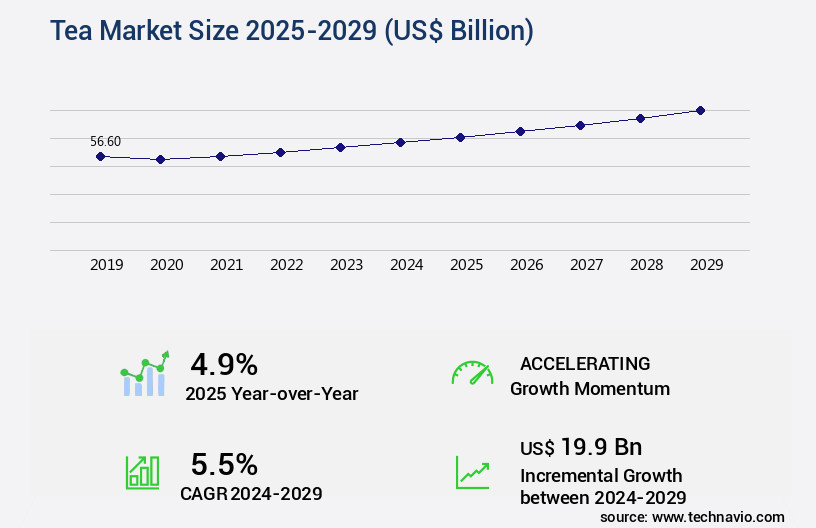
Get Key Insights on Market Forecast (PDF) Request Free Sample
How is the Tea Market Segmented and what are the key trends of market segmentation?
The tea industry research report provides comprehensive data (region-wise segment analysis), with forecasts and estimates in "USD billion" for the period 2025-2029, as well as historical data from 2019-2023 for the following segments.
- Distribution Channel
- Product
- Black tea
- Green tea
- Others
- Form
- Geography
- North America
- Europe
- APAC
- South America
- Rest of World (ROW)
By Distribution Channel Insights
The offline segment is estimated to witness significant growth during the forecast period.
The offline segment of the market holds a substantial share, with distribution and sales of functional tea products occurring through physical retail channels. Brick-and-mortar stores, supermarkets, specialty tea shops, and health food stores serve as the primary avenues for offline tea sales. Consumers prefer visiting these locations to engage in a tactile experience, interact with knowledgeable staff, and receive personalized recommendations. Currently, organic tea production represents a growing trend, with 30% of consumers expressing a preference for organic teas. Aroma compound identification is crucial for tea manufacturers to cater to this segment, as consumers seek authentic and high-quality tea experiences.
Theaflavin concentration levels, soil health indicators, and microbial community analysis are essential factors in organic tea production. Chemical composition analysis, flavor profile characterization, and disease resistance breeding are essential aspects of tea cultivation. Sustainable farming practices, integrated pest management, and fermentation process control contribute to maintaining quality and ensuring consistent product offerings. Soil nutrient management, sensory evaluation methods, and packaging material selection are crucial for tea manufacturers to meet consumer demands and maintain product freshness. Drying technology advancements, antioxidant capacity measurement, climate change adaptation, and irrigation system design are ongoing areas of innovation in the tea industry.
Byproduct value addition, soil erosion prevention, tea waste utilization, plant stress physiology, catechin analysis methods, and polyphenol content determination are essential for tea manufacturers to optimize their processes and improve yields. Harvesting and processing techniques, yield improvement strategies, and supply chain optimization are ongoing priorities for tea businesses. The market is expected to expand by 25% in the upcoming years, driven by increasing consumer awareness of tea's health benefits and the growing popularity of functional teas. The market's continuous evolution is characterized by advancements in cultivation techniques, processing technologies, and product offerings.
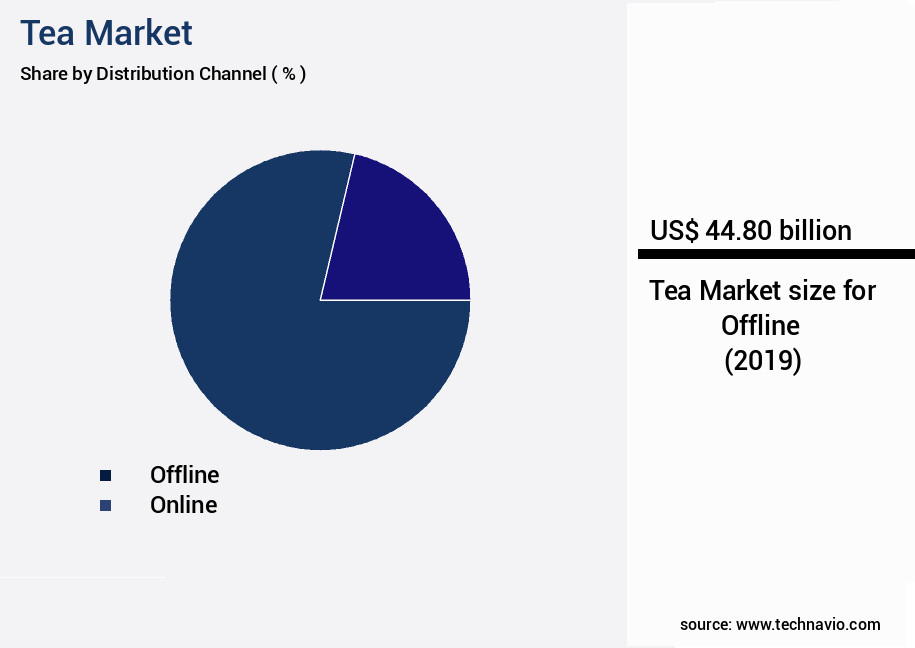
Request Free Sample
The Offline segment was valued at USD 44.80 billion in 2019 and showed a gradual increase during the forecast period.
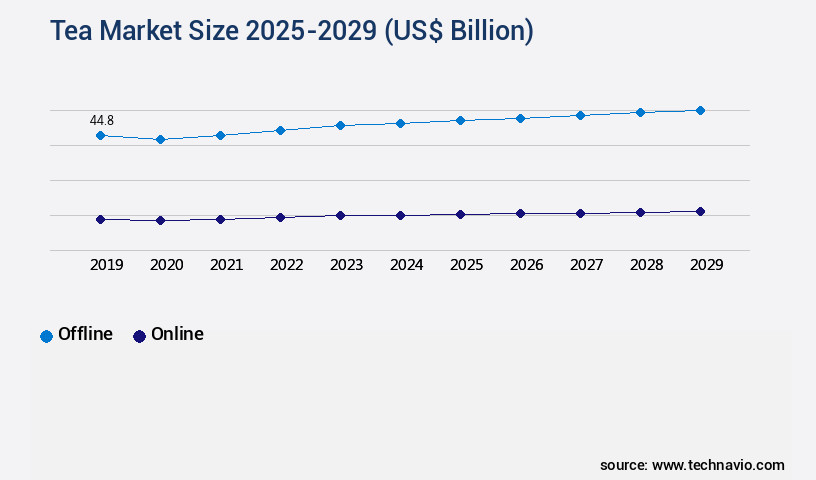
Request Free Sample
Regional Analysis
APAC is estimated to contribute 62% to the growth of the global market during the forecast period.Technavio's analysts have elaborately explained the regional trends and drivers that shape the market during the forecast period.
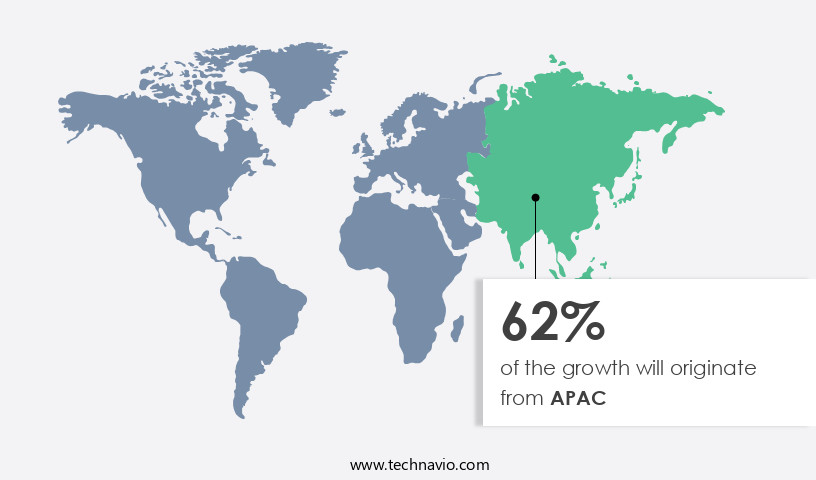
See How Tea Market Demand is Rising in APAC Request Free Sample
In The market landscape of 2024, APAC holds a significant position as a key producer and consumer. China and India, specifically, lead in green tea and black tea production and exports, respectively. Other significant the markets in APAC include Japan, Sri Lanka, Vietnam, and Indonesia. The rising consumption trends are propelling the growth of the market in this region. The APAC the market is poised for substantial expansion during the forecast period.
Market Dynamics
Our researchers analyzed the data with 2024 as the base year, along with the key drivers, trends, and challenges. A holistic analysis of drivers will help companies refine their marketing strategies to gain a competitive advantage.
The market encompasses a diverse range of aspects, from cultivation to processing and consumer preferences. One crucial factor influencing tea production is irrigation, which significantly impacts yield. For instance, optimizing irrigation techniques can enhance yield by up to 30% in areas with water scarcity. Another essential element is the effect of fertilizer type on tea quality. While Organic Fertilizers improve soil health for increased yield, inorganic ones can lead to higher theaflavin content, contributing to better tea quality. Soil microorganisms play a pivotal role in tea growth, and their presence can boost yield by up to 25%.
The optimization of the tea fermentation process is crucial for maintaining consistent tea quality. GC-MS analysis of tea aroma compounds is an effective method for evaluating the quality of different tea types. Additionally, HPLC determination of theaflavin content can help assess the oxidation level and overall quality of tea leaves. Sustainable practices, such as improving soil health and implementing pest and disease management strategies, are increasingly important in tea cultivation. Remote sensing and Precision Agriculture are being employed to optimize tea production and monitor plantations, ensuring efficient use of resources. The influence of processing parameters on tea flavor is a significant market trend.
Climate-resilient tea cultivars are being developed to mitigate the impact of changing weather patterns on tea production. Furthermore, the optimization of tea supply chain operations and analysis of tea polyphenol composition are essential for maintaining product quality and consumer satisfaction. Consumer preference for different tea types varies significantly, with black tea accounting for over 70% of global tea consumption. However, the market for green, oolong, and other tea types is growing rapidly, driven by changing consumer tastes and preferences. Despite its widespread popularity, the tea industry faces challenges related to its environmental impact and water use efficiency.
Addressing these concerns through innovative production methods and sustainable practices is essential for the long-term growth of the market. In conclusion, The market is a dynamic and complex industry, driven by various factors influencing cultivation, processing, and consumer preferences. By addressing these challenges through innovative practices and sustainable production methods, market players can ensure long-term growth and success.
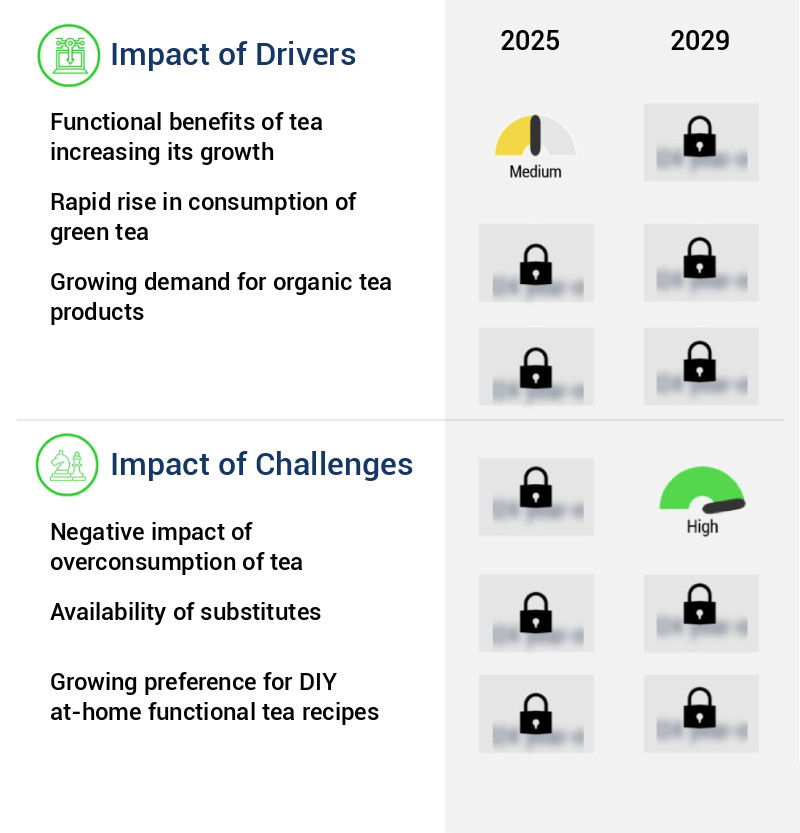
What are the key market drivers leading to the rise in the adoption of Tea Industry?
- The functional benefits of tea, such as its ability to boost energy and improve focus, are the primary drivers fueling market growth.
- Tea consumption offers a myriad of functional and health benefits, with various types providing distinct advantages. white tea, for instance, is renowned for its high antioxidant content. These antioxidants can prevent numerous diseases, including cancer and degenerative conditions, while safeguarding the body from environmental damage. In contrast, green tea boasts lower caffeine levels than coffee, making it an attractive alternative for those seeking a stimulant without the jitters. Furthermore, green tea's consumption is linked to a reduced risk of stroke and heart attack.
- The presence of antioxidants in green tea helps lower LDL cholesterol levels, thereby mitigating the risk of cardiovascular issues. As a professional, it's essential to maintain optimal health, and incorporating these tea types into your daily routine could contribute significantly to your overall well-being.
What are the market trends shaping the Tea Industry?
- New product launches are currently the market trend. This trend reflects the continuous innovation and development in various industries.
- The market is experiencing a significant shift in consumer preferences towards health-focused tea products, such as antioxidant and herbal teas. companies are responding to this trend by introducing innovative new products, expanding their existing tea lines. These new offerings not only attract new consumers but also contribute to increased sales volume and market share. For instance, in June 2024, the Gujarat Cooperative Milk Marketing Federation (GCMMF) is set to extend its organic product range with the launch of Amul Sugar, Jaggery, and Tea.
- This strategic move aims to cater to the growing demand for health-conscious and organic products. The dynamic nature of the market continues to evolve, with companies constantly introducing new tea variants to meet the changing consumer preferences.
What challenges does the Tea Industry face during its growth?
- The overconsumption of tea poses a significant challenge to the industry's growth due to its negative impacts.
- Tea consumption offers numerous health benefits, yet excessive intake can pose potential risks. Nutritionists recommend limiting daily tea consumption to three cups to avoid addiction and potential side effects. Overconsumption can lead to dehydration due to caffeine's diuretic effect, causing the body to lose essential fluids. Additionally, excessive tea consumption may result in bloating, caused by water retention due to dehydration.
- Nutrient deficiencies and anxiety are other potential risks associated with high tea intake. The caffeine content in tea, responsible for these effects, can inhibit the absorption of essential minerals and vitamins. Maintain a balanced and moderate tea consumption routine for optimal health benefits.
Exclusive Technavio Analysis on Customer Landscape
The tea market forecasting report includes the adoption lifecycle of the market, covering from the innovator's stage to the laggard's stage. It focuses on adoption rates in different regions based on penetration. Furthermore, the tea market report also includes key purchase criteria and drivers of price sensitivity to help companies evaluate and develop their market growth analysis strategies.
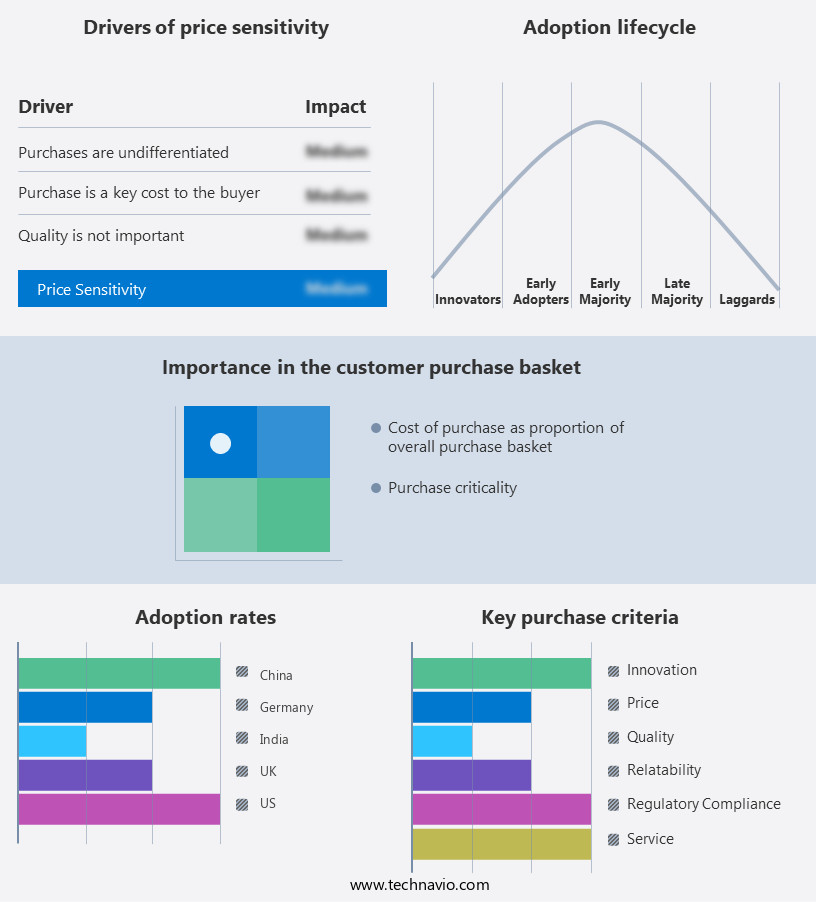
Customer Landscape of Tea Industry
Competitive Landscape
Companies are implementing various strategies, such as strategic alliances, tea market forecast, partnerships, mergers and acquisitions, geographical expansion, and product/service launches, to enhance their presence in the industry.
Assam Company India - This global tea provider showcases an extensive selection of premium teas, encompassing Ceylon, green, black, flavored black, and flavored green varieties. Each tea type undergoes rigorous quality control processes to ensure authenticity and superior taste.
The industry research and growth report includes detailed analyses of the competitive landscape of the market and information about key companies, including:
- Assam Company India
- Akbar Group
- Apeejay Surrendra Group
- Associated British Foods Plc
- Barrys Tea
- Fukujuen Co. Ltd.
- Godrej and Boyce Manufacturing Co. Ltd.
- Harney and Sons Fine Teas
- ITO EN Ltd.
- LIPTON Teas and Infusions
- Mighty Leaf Tea Canada
- M.M.Ispahani LTD.
- Nestle SA
- Numi Inc.
- senchasou.co,ltd.
- Tata Consumer Products Ltd.
- The Hain Celestial Group Inc.
- The Republic of Tea Inc.
- Williamson Magor Group
- Yunnan Dayi Tea Industry Group Co. Ltd.
Qualitative and quantitative analysis of companies has been conducted to help clients understand the wider business environment as well as the strengths and weaknesses of key industry players. Data is qualitatively analyzed to categorize companies as pure play, category-focused, industry-focused, and diversified; it is quantitatively analyzed to categorize companies as dominant, leading, strong, tentative, and weak.
Recent Development and News in Tea Market
- In January 2024, Unilever, a leading consumer goods company, announced the launch of a new line of premium tea bags infused with herbs and fruits under the brand Lipton, aiming to cater to the growing demand for healthier and flavored tea options (Unilever Press Release).
- In March 2024, Starbucks Corporation and Tazo Tea Company, a Starbucks brand, entered into a strategic partnership with Teavana Holdings, a specialty tea retailer, to expand their tea offerings and enhance the in-store tea experience for customers (Starbucks Press Release).
- In May 2024, Dilmah Tea, a leading tea producer, completed the acquisition of a 50% stake in Mövenpick Foods AG's tea business, expanding its global reach and strengthening its presence in the European market (Dilmah Tea Press Release).
- In April 2025, the European Union approved the use of organic farming practices for tea cultivation, paving the way for increased production and exports of organic tea from countries like Sri Lanka and India, in response to growing consumer demand for organic and sustainable tea products (European Commission Press Release).
Dive into Technavio's robust research methodology, blending expert interviews, extensive data synthesis, and validated models for unparalleled Tea Market insights. See full methodology.
|
Market Scope
|
|
Report Coverage
|
Details
|
|
Page number
|
197
|
|
Base year
|
2024
|
|
Historic period
|
2019-2023 |
|
Forecast period
|
2025-2029
|
|
Growth momentum & CAGR
|
Accelerate at a CAGR of 5.5%
|
|
Market growth 2025-2029
|
USD 19.9 billion
|
|
Market structure
|
Fragmented
|
|
YoY growth 2024-2025(%)
|
4.9
|
|
Key countries
|
India, China, UK, Japan, Germany, US, France, Italy, Canada, and Brazil
|
|
Competitive landscape
|
Leading Companies, Market Positioning of Companies, Competitive Strategies, and Industry Risks
|
Request Free Sample
Research Analyst Overview
- In the dynamic and evolving world of organic tea production, various aspects continue to shape the industry's landscape. Aroma compound identification plays a crucial role in enhancing tea's distinctive flavors, with researchers focusing on the identification and quantification of key aroma compounds. Theaflavin concentration levels, essential for tea's unique taste and health benefits, are meticulously monitored and optimized through advanced production techniques. Soil health indicators, microbial community analysis, and chemical composition analysis are integral components of sustainable farming practices. These methods ensure the long-term viability of tea cultivation by promoting soil fertility, maintaining a balanced ecosystem, and minimizing the use of synthetic fertilizers and pesticides.
- Disease resistance breeding, integrated pest management, and fermentation process control are essential for maintaining optimal tea production. Quality control procedures, soil nutrient management, and sensory evaluation methods are implemented to ensure the highest standards of tea are consistently produced. Packaging material selection, drying technology advancements, and antioxidant capacity measurement are critical aspects of the tea industry's evolution. These innovations aim to preserve tea's quality, extend its shelf life, and enhance its health benefits. Climate change adaptation, irrigation system design, byproduct value addition, soil erosion prevention, and tea waste utilization are increasingly important areas of focus. These initiatives not only contribute to the industry's sustainability but also help tea producers adapt to the challenges posed by a changing environment.
- Plant stress physiology, catechin analysis methods, polyphenol content determination, and tea cultivation techniques are essential for optimizing tea production and improving yield. Water resource management, tea plant varieties, harvesting and processing, and yield improvement strategies are other key areas of ongoing research and development. Through continuous innovation and a commitment to sustainable practices, the organic tea industry continues to evolve, offering consumers high-quality, healthful, and environmentally responsible tea products.
What are the Key Data Covered in this Tea Market Research and Growth Report?
-
What is the expected growth of the Tea Market between 2025 and 2029?
-
What segmentation does the market report cover?
-
The report is segmented by Distribution Channel (Offline and Online), Product (Black tea, Green tea, and Others), Geography (APAC, Europe, North America, South America, and Middle East and Africa), and Form (Leaf Tea, CTC Tea, Others, Leaf Tea, CTC Tea, and Others)
-
Which regions are analyzed in the report?
-
APAC, Europe, North America, South America, and Middle East and Africa
-
What are the key growth drivers and market challenges?
-
Who are the major players in the Tea Market?
-
Assam Company India, Akbar Group, Apeejay Surrendra Group, Associated British Foods Plc, Barrys Tea, Fukujuen Co. Ltd., Godrej and Boyce Manufacturing Co. Ltd., Harney and Sons Fine Teas, ITO EN Ltd., LIPTON Teas and Infusions, Mighty Leaf Tea Canada, M.M.Ispahani LTD., Nestle SA, Numi Inc., senchasou.co,ltd., Tata Consumer Products Ltd., The Hain Celestial Group Inc., The Republic of Tea Inc., Williamson Magor Group, and Yunnan Dayi Tea Industry Group Co. Ltd.
Market Research Insights
- The market encompasses a diverse range of products and processes, with an estimated annual production of 5.5 million metric tons in 2020 and projected growth to reach 6.5 million tons by 2025. Consumer preference mapping and sensory attribute analysis play significant roles in shaping market trends, with flavor compound biosynthesis and infusion parameters optimization being key areas of focus for producers. Crop diversification strategies, microbial inoculant application, and nutrient cycling pathways are essential elements of sustainable tea farming. Precision agriculture techniques, yield prediction models, and plant growth regulators are utilized to optimize crop yield and improve nutrient uptake efficiency.
- The integration of technology, such as photosynthetic efficiency monitoring and remote sensing applications, enables more efficient and effective farming practices. Environmental impact assessment and pest resistance mechanisms are crucial considerations for tea producers seeking to minimize their carbon footprint and maintain high-quality products. The market's continuous evolution is driven by ongoing research in areas such as plant hormone interactions, quality control metrics, and packaging technology.
We can help! Our analysts can customize this tea market research report to meet your requirements.
Get in touch
1 Executive Summary
- 1.1 Market overview
- Executive Summary - Chart on Market Overview
- Executive Summary - Data Table on Market Overview
- Executive Summary - Chart on Global Market Characteristics
- Executive Summary - Chart on Market by Geography
- Executive Summary - Chart on Market Segmentation by Distribution Channel
- Executive Summary - Chart on Market Segmentation by Product
- Executive Summary - Chart on Incremental Growth
- Executive Summary - Data Table on Incremental Growth
- Executive Summary - Chart on Company Market Positioning
2 Technavio Analysis
- 2.1 Analysis of price sensitivity, lifecycle, customer purchase basket, adoption rates, and purchase criteria
- Analysis of price sensitivity, lifecycle, customer purchase basket, adoption rates, and purchase criteria
- 2.2 Criticality of inputs and Factors of differentiation
- Overview on criticality of inputs and factors of differentiation
- 2.3 Factors of disruption
- Overview on factors of disruption
- 2.4 Impact of drivers and challenges
- Impact of drivers and challenges in 2024 and 2029
3 Market Landscape
- 3.1 Market ecosystem
- Parent Market
- Data Table on - Parent Market
- 3.2 Market characteristics
- Market characteristics analysis
4 Market Sizing
- 4.1 Market definition
- Offerings of companies included in the market definition
- 4.2 Market segment analysis
- 4.4 Market outlook: Forecast for 2024-2029
- Chart on Global - Market size and forecast 2024-2029 ($ billion)
- Data Table on Global - Market size and forecast 2024-2029 ($ billion)
- Chart on Global Market: Year-over-year growth 2024-2029 (%)
- Data Table on Global Market: Year-over-year growth 2024-2029 (%)
5 Historic Market Size
- 5.1 Global Tea Market 2019 - 2023
- Historic Market Size - Data Table on Global Tea Market 2019 - 2023 ($ billion)
- 5.2 Distribution Channel segment analysis 2019 - 2023
- Historic Market Size - Distribution Channel Segment 2019 - 2023 ($ billion)
- 5.3 Product segment analysis 2019 - 2023
- Historic Market Size - Product Segment 2019 - 2023 ($ billion)
- 5.4 Geography segment analysis 2019 - 2023
- Historic Market Size - Geography Segment 2019 - 2023 ($ billion)
- 5.5 Country segment analysis 2019 - 2023
- Historic Market Size - Country Segment 2019 - 2023 ($ billion)
6 Qualitative Analysis
- 6.1 Impact of AI on the Global Tea Market
7 Five Forces Analysis
- 7.1 Five forces summary
- Five forces analysis - Comparison between 2024 and 2029
- 7.2 Bargaining power of buyers
- Bargaining power of buyers - Impact of key factors 2024 and 2029
- 7.3 Bargaining power of suppliers
- Bargaining power of suppliers - Impact of key factors in 2024 and 2029
- 7.4 Threat of new entrants
- Threat of new entrants - Impact of key factors in 2024 and 2029
- 7.5 Threat of substitutes
- Threat of substitutes - Impact of key factors in 2024 and 2029
- 7.6 Threat of rivalry
- Threat of rivalry - Impact of key factors in 2024 and 2029
- 7.7 Market condition
- Chart on Market condition - Five forces 2024 and 2029
8 Market Segmentation by Distribution Channel
- 8.1 Market segments
- Chart on Distribution Channel - Market share 2024-2029 (%)
- Data Table on Distribution Channel - Market share 2024-2029 (%)
- 8.2 Comparison by Distribution Channel
- Chart on Comparison by Distribution Channel
- Data Table on Comparison by Distribution Channel
- 8.3 Offline - Market size and forecast 2024-2029
- Chart on Offline - Market size and forecast 2024-2029 ($ billion)
- Data Table on Offline - Market size and forecast 2024-2029 ($ billion)
- Chart on Offline - Year-over-year growth 2024-2029 (%)
- Data Table on Offline - Year-over-year growth 2024-2029 (%)
- 8.4 Online - Market size and forecast 2024-2029
- Chart on Online - Market size and forecast 2024-2029 ($ billion)
- Data Table on Online - Market size and forecast 2024-2029 ($ billion)
- Chart on Online - Year-over-year growth 2024-2029 (%)
- Data Table on Online - Year-over-year growth 2024-2029 (%)
- 8.5 Market opportunity by Distribution Channel
- Market opportunity by Distribution Channel ($ billion)
- Data Table on Market opportunity by Distribution Channel ($ billion)
9 Market Segmentation by Product
- 9.1 Market segments
- Chart on Product - Market share 2024-2029 (%)
- Data Table on Product - Market share 2024-2029 (%)
- 9.2 Comparison by Product
- Chart on Comparison by Product
- Data Table on Comparison by Product
- 9.3 Black tea - Market size and forecast 2024-2029
- Chart on Black tea - Market size and forecast 2024-2029 ($ billion)
- Data Table on Black tea - Market size and forecast 2024-2029 ($ billion)
- Chart on Black tea - Year-over-year growth 2024-2029 (%)
- Data Table on Black tea - Year-over-year growth 2024-2029 (%)
- 9.4 Green tea - Market size and forecast 2024-2029
- Chart on Green tea - Market size and forecast 2024-2029 ($ billion)
- Data Table on Green tea - Market size and forecast 2024-2029 ($ billion)
- Chart on Green tea - Year-over-year growth 2024-2029 (%)
- Data Table on Green tea - Year-over-year growth 2024-2029 (%)
- 9.5 Others - Market size and forecast 2024-2029
- Chart on Others - Market size and forecast 2024-2029 ($ billion)
- Data Table on Others - Market size and forecast 2024-2029 ($ billion)
- Chart on Others - Year-over-year growth 2024-2029 (%)
- Data Table on Others - Year-over-year growth 2024-2029 (%)
- 9.6 Market opportunity by Product
- Market opportunity by Product ($ billion)
- Data Table on Market opportunity by Product ($ billion)
10 Market Segmentation by Form
- 10.1 Market segments
- Chart on Form - Market share (2024-2029) (%)
- Data Table on Form - Market share (2024-2029) (%)
- 10.2 Comparison by Form
- Chart on Comparison by Form
- Data Table on Comparison by Form
- 10.3 Leaf Tea - Market size and forecast (2024-2029)
- Chart on Leaf Tea - Market size and forecast (2024-2029) ($ million)
- Data Table on Leaf Tea - Market size and forecast (2024-2029) ($ million)
- Chart on Leaf Tea - Year-over-year growth (2024-2029) (%)
- Data Table on Leaf Tea - Year-over-year growth (2024-2029) (%)
- 10.4 CTC Tea - Market size and forecast (2024-2029)
- Chart on CTC Tea - Market size and forecast (2024-2029) ($ million)
- Data Table on CTC Tea - Market size and forecast (2024-2029) ($ million)
- Chart on CTC Tea - Year-over-year growth (2024-2029) (%)
- Data Table on CTC Tea - Year-over-year growth (2024-2029) (%)
- 10.5 Others - Market size and forecast (2024-2029)
- Chart on Others - Market size and forecast (2024-2029) ($ million)
- Data Table on Others - Market size and forecast (2024-2029) ($ million)
- Chart on Others - Year-over-year growth (2024-2029) (%)
- Data Table on Others - Year-over-year growth (2024-2029) (%)
- 10.6 Market opportunity by Form
- Market opportunity by $segment_name ($ million)
- Data Table on Market opportunity by $segment_name ($ million)
11 Customer Landscape
- 11.1 Customer landscape overview
- Analysis of price sensitivity, lifecycle, customer purchase basket, adoption rates, and purchase criteria
12 Geographic Landscape
- 12.1 Geographic segmentation
- Chart on Market share by geography 2024-2029 (%)
- Data Table on Market share by geography 2024-2029 (%)
- 12.2 Geographic comparison
- Chart on Geographic comparison
- Data Table on Geographic comparison
- 12.3 APAC - Market size and forecast 2024-2029
- Chart on APAC - Market size and forecast 2024-2029 ($ billion)
- Data Table on APAC - Market size and forecast 2024-2029 ($ billion)
- Chart on APAC - Year-over-year growth 2024-2029 (%)
- Data Table on APAC - Year-over-year growth 2024-2029 (%)
- 12.4 Europe - Market size and forecast 2024-2029
- Chart on Europe - Market size and forecast 2024-2029 ($ billion)
- Data Table on Europe - Market size and forecast 2024-2029 ($ billion)
- Chart on Europe - Year-over-year growth 2024-2029 (%)
- Data Table on Europe - Year-over-year growth 2024-2029 (%)
- 12.5 North America - Market size and forecast 2024-2029
- Chart on North America - Market size and forecast 2024-2029 ($ billion)
- Data Table on North America - Market size and forecast 2024-2029 ($ billion)
- Chart on North America - Year-over-year growth 2024-2029 (%)
- Data Table on North America - Year-over-year growth 2024-2029 (%)
- 12.6 South America - Market size and forecast 2024-2029
- Chart on South America - Market size and forecast 2024-2029 ($ billion)
- Data Table on South America - Market size and forecast 2024-2029 ($ billion)
- Chart on South America - Year-over-year growth 2024-2029 (%)
- Data Table on South America - Year-over-year growth 2024-2029 (%)
- 12.7 Middle East and Africa - Market size and forecast 2024-2029
- Chart on Middle East and Africa - Market size and forecast 2024-2029 ($ billion)
- Data Table on Middle East and Africa - Market size and forecast 2024-2029 ($ billion)
- Chart on Middle East and Africa - Year-over-year growth 2024-2029 (%)
- Data Table on Middle East and Africa - Year-over-year growth 2024-2029 (%)
- 12.8 India - Market size and forecast 2024-2029
- Chart on India - Market size and forecast 2024-2029 ($ billion)
- Data Table on India - Market size and forecast 2024-2029 ($ billion)
- Chart on India - Year-over-year growth 2024-2029 (%)
- Data Table on India - Year-over-year growth 2024-2029 (%)
- 12.9 China - Market size and forecast 2024-2029
- Chart on China - Market size and forecast 2024-2029 ($ billion)
- Data Table on China - Market size and forecast 2024-2029 ($ billion)
- Chart on China - Year-over-year growth 2024-2029 (%)
- Data Table on China - Year-over-year growth 2024-2029 (%)
- 12.10 UK - Market size and forecast 2024-2029
- Chart on UK - Market size and forecast 2024-2029 ($ billion)
- Data Table on UK - Market size and forecast 2024-2029 ($ billion)
- Chart on UK - Year-over-year growth 2024-2029 (%)
- Data Table on UK - Year-over-year growth 2024-2029 (%)
- 12.11 Japan - Market size and forecast 2024-2029
- Chart on Japan - Market size and forecast 2024-2029 ($ billion)
- Data Table on Japan - Market size and forecast 2024-2029 ($ billion)
- Chart on Japan - Year-over-year growth 2024-2029 (%)
- Data Table on Japan - Year-over-year growth 2024-2029 (%)
- 12.12 Germany - Market size and forecast 2024-2029
- Chart on Germany - Market size and forecast 2024-2029 ($ billion)
- Data Table on Germany - Market size and forecast 2024-2029 ($ billion)
- Chart on Germany - Year-over-year growth 2024-2029 (%)
- Data Table on Germany - Year-over-year growth 2024-2029 (%)
- 12.13 US - Market size and forecast 2024-2029
- Chart on US - Market size and forecast 2024-2029 ($ billion)
- Data Table on US - Market size and forecast 2024-2029 ($ billion)
- Chart on US - Year-over-year growth 2024-2029 (%)
- Data Table on US - Year-over-year growth 2024-2029 (%)
- 12.14 France - Market size and forecast 2024-2029
- Chart on France - Market size and forecast 2024-2029 ($ billion)
- Data Table on France - Market size and forecast 2024-2029 ($ billion)
- Chart on France - Year-over-year growth 2024-2029 (%)
- Data Table on France - Year-over-year growth 2024-2029 (%)
- 12.15 Italy - Market size and forecast 2024-2029
- Chart on Italy - Market size and forecast 2024-2029 ($ billion)
- Data Table on Italy - Market size and forecast 2024-2029 ($ billion)
- Chart on Italy - Year-over-year growth 2024-2029 (%)
- Data Table on Italy - Year-over-year growth 2024-2029 (%)
- 12.16 Canada - Market size and forecast 2024-2029
- Chart on Canada - Market size and forecast 2024-2029 ($ billion)
- Data Table on Canada - Market size and forecast 2024-2029 ($ billion)
- Chart on Canada - Year-over-year growth 2024-2029 (%)
- Data Table on Canada - Year-over-year growth 2024-2029 (%)
- 12.17 Brazil - Market size and forecast 2024-2029
- Chart on Brazil - Market size and forecast 2024-2029 ($ billion)
- Data Table on Brazil - Market size and forecast 2024-2029 ($ billion)
- Chart on Brazil - Year-over-year growth 2024-2029 (%)
- Data Table on Brazil - Year-over-year growth 2024-2029 (%)
- 12.18 Market opportunity by geography
- Market opportunity by geography ($ billion)
- Data Tables on Market opportunity by geography ($ billion)
13 Drivers, Challenges, and Opportunity/Restraints
- 13.3 Impact of drivers and challenges
- Impact of drivers and challenges in 2024 and 2029
- 13.4 Market opportunities/restraints
14 Competitive Landscape
- 14.2 Competitive Landscape
- Overview on criticality of inputs and factors of differentiation
- 14.3 Landscape disruption
- Overview on factors of disruption
- 14.4 Industry risks
- Impact of key risks on business
15 Competitive Analysis
- 15.2 Company ranking index
- 15.3 Market positioning of companies
- Matrix on companies position and classification
- 15.4 Akbar Group
- Akbar Group - Overview
- Akbar Group - Product / Service
- Akbar Group - Key offerings
- SWOT
- 15.5 Apeejay Surrendra Group
- Apeejay Surrendra Group - Overview
- Apeejay Surrendra Group - Product / Service
- Apeejay Surrendra Group - Key offerings
- SWOT
- 15.6 Associated British Foods Plc
- Associated British Foods Plc - Overview
- Associated British Foods Plc - Business segments
- Associated British Foods Plc - Key offerings
- Associated British Foods Plc - Segment focus
- SWOT
- 15.7 Barrys Tea
- Barrys Tea - Overview
- Barrys Tea - Product / Service
- Barrys Tea - Key offerings
- SWOT
- 15.8 Fukujuen Co. Ltd.
- Fukujuen Co. Ltd. - Overview
- Fukujuen Co. Ltd. - Product / Service
- Fukujuen Co. Ltd. - Key offerings
- SWOT
- 15.9 Godrej and Boyce Manufacturing Co. Ltd.
- Godrej and Boyce Manufacturing Co. Ltd. - Overview
- Godrej and Boyce Manufacturing Co. Ltd. - Product / Service
- Godrej and Boyce Manufacturing Co. Ltd. - Key offerings
- SWOT
- 15.10 ITO EN Ltd.
- ITO EN Ltd. - Overview
- ITO EN Ltd. - Business segments
- ITO EN Ltd. - Key offerings
- ITO EN Ltd. - Segment focus
- SWOT
- 15.11 LIPTON Teas and Infusions
- LIPTON Teas and Infusions - Overview
- LIPTON Teas and Infusions - Product / Service
- LIPTON Teas and Infusions - Key offerings
- SWOT
- 15.12 Nestle SA
- Nestle SA - Overview
- Nestle SA - Business segments
- Nestle SA - Key news
- Nestle SA - Key offerings
- Nestle SA - Segment focus
- SWOT
- 15.13 senchasou.co,ltd.
- senchasou.co,ltd. - Overview
- senchasou.co,ltd. - Product / Service
- senchasou.co,ltd. - Key offerings
- SWOT
- 15.14 Tata Consumer Products Ltd.
- Tata Consumer Products Ltd. - Overview
- Tata Consumer Products Ltd. - Business segments
- Tata Consumer Products Ltd. - Key news
- Tata Consumer Products Ltd. - Key offerings
- Tata Consumer Products Ltd. - Segment focus
- SWOT
- 15.15 The Hain Celestial Group Inc.
- The Hain Celestial Group Inc. - Overview
- The Hain Celestial Group Inc. - Business segments
- The Hain Celestial Group Inc. - Key news
- The Hain Celestial Group Inc. - Key offerings
- The Hain Celestial Group Inc. - Segment focus
- SWOT
- 15.16 The Republic of Tea Inc.
- The Republic of Tea Inc. - Overview
- The Republic of Tea Inc. - Product / Service
- The Republic of Tea Inc. - Key offerings
- SWOT
- 15.17 Williamson Magor Group
- Williamson Magor Group - Overview
- Williamson Magor Group - Product / Service
- Williamson Magor Group - Key offerings
- SWOT
- 15.18 Yunnan Dayi Tea Industry Group Co. Ltd.
- Yunnan Dayi Tea Industry Group Co. Ltd. - Overview
- Yunnan Dayi Tea Industry Group Co. Ltd. - Product / Service
- Yunnan Dayi Tea Industry Group Co. Ltd. - Key offerings
- SWOT
16 Appendix
- 16.2 Inclusions and exclusions checklist
- Inclusions checklist
- Exclusions checklist
- 16.3 Currency conversion rates for US$
- Currency conversion rates for US$
- 16.4 Research methodology
- 16.7 Validation techniques employed for market sizing
- Validation techniques employed for market sizing
- 16.9 360 degree market analysis
- 360 degree market analysis
- 16.10 List of abbreviations







![]() Get the report (PDF) sent to your email within minutes.
Get the report (PDF) sent to your email within minutes.
Complimentary full Excel data with your report purchase.